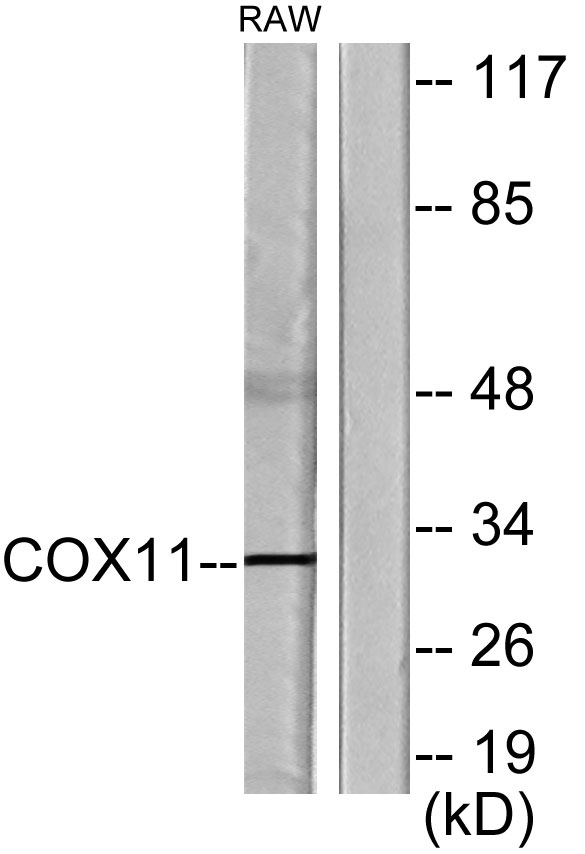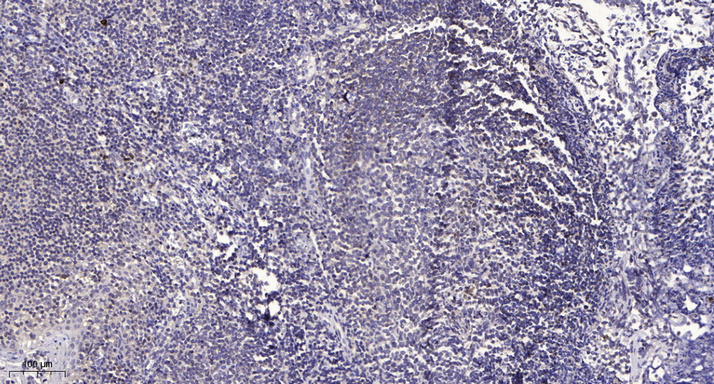COX11 Polyclonal Antibody
- Catalog No.:YT1069
- Applications:WB;IHC;IF;ELISA
- Reactivity:Human;Mouse
- Target:
- COX11
- Fields:
- >>Oxidative phosphorylation;>>Metabolic pathways;>>Thermogenesis
- Gene Name:
- COX11
- Protein Name:
- Cytochrome c oxidase assembly protein COX11 mitochondrial
- Human Gene Id:
- 1353
- Human Swiss Prot No:
- Q9Y6N1
- Mouse Gene Id:
- 69802
- Mouse Swiss Prot No:
- Q6P8I6
- Immunogen:
- The antiserum was produced against synthesized peptide derived from human COX11. AA range:51-100
- Specificity:
- COX11 Polyclonal Antibody detects endogenous levels of COX11 protein.
- Formulation:
- Liquid in PBS containing 50% glycerol, 0.5% BSA and 0.02% sodium azide.
- Source:
- Polyclonal, Rabbit,IgG
- Dilution:
- WB 1:500 - 1:2000. IHC 1:100 - 1:300. IF 1:200 - 1:1000. ELISA: 1:5000. Not yet tested in other applications.
- Purification:
- The antibody was affinity-purified from rabbit antiserum by affinity-chromatography using epitope-specific immunogen.
- Concentration:
- 1 mg/ml
- Storage Stability:
- -15°C to -25°C/1 year(Do not lower than -25°C)
- Other Name:
- COX11;Cytochrome c oxidase assembly protein COX11; mitochondrial
- Observed Band(KD):
- 31kD
- Background:
- Cytochrome c oxidase (COX), the terminal component of the mitochondrial respiratory chain, catalyzes the electron transfer from reduced cytochrome c to oxygen. This component is a heteromeric complex consisting of 3 catalytic subunits encoded by mitochondrial genes and multiple structural subunits encoded by nuclear genes. The mitochondrially-encoded subunits function in electron transfer, and the nuclear-encoded subunits may function in the regulation and assembly of the complex. This nuclear gene encodes a protein which is not a structural subunit, but may be a heme A biosynthetic enzyme involved in COX formation, according to the yeast mutant studies. However, the studies in Rhodobacter sphaeroides suggest that this gene is not required for heme A biosynthesis, but required for stable formation of the Cu(B) and magnesium centers of COX. This human protein is predicted to c
- Function:
- function:Exerts its effect at some terminal stage of cytochrome c oxidase synthesis, probably by being involved in the insertion of the copper B into subunit I.,similarity:Belongs to the COX11/ctaG family.,subunit:Interacts with CNNM4/ACDP4.,tissue specificity:Ubiquitous.,
- Subcellular Location:
- Mitochondrion inner membrane ; Single-pass membrane protein ; Intermembrane side .
- Expression:
- Ubiquitous.
- June 19-2018
- WESTERN IMMUNOBLOTTING PROTOCOL
- June 19-2018
- IMMUNOHISTOCHEMISTRY-PARAFFIN PROTOCOL
- June 19-2018
- IMMUNOFLUORESCENCE PROTOCOL
- September 08-2020
- FLOW-CYTOMEYRT-PROTOCOL
- May 20-2022
- Cell-Based ELISA│解您多样本WB检测之困扰
- July 13-2018
- CELL-BASED-ELISA-PROTOCOL-FOR-ACETYL-PROTEIN
- July 13-2018
- CELL-BASED-ELISA-PROTOCOL-FOR-PHOSPHO-PROTEIN
- July 13-2018
- Antibody-FAQs
- Products Images

- Western blot analysis of lysates from RAW264.7 cells, using COX11 Antibody. The lane on the right is blocked with the synthesized peptide.

- Immunohistochemical analysis of paraffin-embedded human tonsil. 1, Antibody was diluted at 1:200(4° overnight). 2, Tris-EDTA,pH9.0 was used for antigen retrieval. 3,Secondary antibody was diluted at 1:200(room temperature, 30min).



